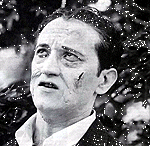
NIGHT OF THE LIVING DEAD
F.A.Q.Why is there a naked lady walking around for?
If you look closely or catch a still, you will see a morgue tag on her
("Smyth, Carol"). In the remake, they hired another nude and had a few
more obvious morgue or autopsy males.
How could the morgue lady wind up in rural Pennsylvania?
The filmmakers can’t explain this one. This applies to most of the living
dead that seemingly congregated at the one farmhouse.
How did so many zombies end up in the countryside?
This has no logical explanation, like the one above.
Why do the zombies look plain/normal?
They're the unburied, recently dead. They have not crawled out of the ground
or anything. Romero also wanted them to look like everyday people to make people
think they're normal. He says "They’re your neighbors. Sometimes the
neighbors are the most frightening people you'll ever face."
Where is George Romero in the movie?
He plays the tall reporter in Washington asking if there is a connection
between the mutations.
Where is John Russo in the movie?
Russo first appears as a ghoul that Ben kills with a tire iron in the house
(the one that blinks).
Then as the general's driver in Washington.

Where's Marilyn Eastman as a zombie?
She is the one that eats an insect off a tree.
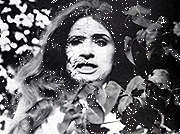
Hey there's a window they forgot to board up! Mistake!
Yes there is an unboarded window for good reason. Russo explains,
"we didn't board up that window because outside there was a 15 ft. drop. No
zombies could have accessed it."
Who attacked the lady upstairs?
It could have been any of the zombies that later turn up near the house or
the character referenced in the novelization Russo wrote (which is not clearly
identified in the movie because they hadn’t thought about it that deeply).
Who was the lady upstairs?
The lady is referred to as Miss Miller in the novel but the script refers to
her as the former owner of the house.
Why did the lady upstairs not revive as a zombie?
Russo and Romero have both reasoned that she had her head suffer severe
trauma and her brain might have been eaten along with her face.
So why did Johnny revive as a zombie if he suffered brain death?
Russo and Romero have reasoned that Johnny was knocked out and probably
later attacked again doing him in for real. In the remake, Johnny did not revive
because the brain injury was severe.
Why did Romero make the hero black? Was this to make a controversial
statement for the 60s?
This is fully described in the Production
section. In a nutshell, he wasn't scripted as a black character, he was
envisioned as a white hillbilly. Duane Jones was cast because of his talented
reading of the lines.
Why do the zombies break the headlights?
Don't all monsters loathe light? Truthfully this was unnecessary, as Romero
realized by leaving it out of the remake.
Why did the zombie hit by tire iron blink his eye when Barbara stared at
him?
John Russo played this zombie and claims that "it was an intentional
blink...a death twitch might have sold the idea that he was still alive." I
know, I know, sounds dumb, but remember that the body seems to move again a
moment later, when it is dragged out of frame.
Why did the zombie hit in the face by a tire iron hold his face as if in
pain if he is already dead and unfeeling?
AND
Why did one zombie (near the end) cover his eyes when shot from behind?
You can say instinct but most realize that when they were shooting, they didn't
really have all the rules of zombie behavior outlined and down to a science.
These may be considered mistakes and are included in the Mistakes
section.
Is there a color version of NOTLD? - I see color shots in your site.
NOTLD was not shot in color, those are from a color film camera. NOTLD was colorized
however by Hal Roach Studios in 1986 in the first of the Russo-authorized
desecrations to make some money off of it. NOTLD was also remade in color.
Why did they film in just black and white?
Color 35mm was too expensive for the filmmakers at the time. But this enabled a
nostalgic look and hid its inadequacies well.
Were there any disasters on the set?
Yes, one of them is when [sound man] Gary Streiner was in charge of
relighting the chair fire when it had to be filmed. He caught fire one night
when his arm was accidentally doused with lighter fluid. Bill Hinzman had to
tackle him to roll him on the ground.
Are there any alternate versions of NOTLD - different endings, different angles,
etc?
No. The alternate 'cutting room floor' stuff was damaged in a Pennsylvania
flood in 1972. Also lost forever were hundreds of stills in the Latent
Image offices. For what was missing - see Distribution.
There ARE versions of NOTLD of varying quality since they were transferred from
different source prints. The best are the versions with Walter Reade leader.
Romero taped a intro that was tacked on to the film for release by Laurel in
1982. Both of these have made it to video and cable, and one release has
both before the movie. There aren't really any alternate versions of the
original Night save for a television edit where Barbara, entering the
farmhouse door, is cut.


Beware of the 30th
Anniversary 'Special Edition' (info here).
This version does not have lost footage restored but rather "new"
footage and a lame substory.
Is NOTLD MPAA rated? - it doesn't have a swear word or sex but brief
nudity/violence/gore.
It was released without a rating and was never submitted for one (the
distributor Continental Pictures didn't yet subscribe to the system which started
a month after the film premiered ). See
Distribution section for details.
What television channels have shown NOTLD?
NOTLD has been shown far too many times to keep count. During the 70s, it
appeared late night on various channels. Interestingly in Pittsburgh area
airings, Romero remembers the rescue stations blacked out and/or a disclaimer
announcing that it wasn't real and to not report to the rescue stations flashing
on screen. In the 80s, HBO showed it a bit in 1984 and MTV broadcast it on
Halloween. The USA Network used to air NOTLD every New Years Eve at around 11
P.M. (with Animal Crackers and The Inspector General following).
In 1988, they aired NOTLD and Day of the Dead back to back with guest
host Gilbert Gottfried. The Special Edition was aired on Cinemax February 4,
2002.
What did the TV Guide say about NOTLD?
NOTLD has been on so many times they don't say much of anything; it's hardly
an event. For the record the reviews are good:
Night of the Living Dead
(1968)
NR: GV. Shocker about a plague
of zombies loose in Pennsylvania.
Barbara: Judith O'Dea. Johnny:
Russell Streiner. (1 hr. 40 min. H H
H)
The TV Book, included with most national newspapers, have a better synopsis, although as time went on, and space diminished, the capsule got vaguer.
Night of the Living Dead
H H H (68,Night of the Living Dead
H H H (68,Night of the Living Dead
H H H (68,Why didn't Tom Savini do the makeup?
Tom was going to but was drafted into the Vietnam War. See Pre-Production.
What awards has NOTLD won?
No awards other than various horror hall of fame honors and polls, and
permanent exhibition at the Metropolitan Museum of Art (!)
Hey that is the same music in that scene in Ren and Stimpy...or Amazon Women On
the Moon or...
The music used in NOTLD is patchworked needledrop library tracks, and you
can hear portions in films even before 1968 like The
Hideous Sun Demon, Space
Master X-7,
Teenagers From Outer Space, Terror
From the Year 5000 and many
others.
Is the farmhouse still somewhere I can visit?
No, it was burned down after the movie was made by the owners. I know,
thousands of dollars potentially lost as a tourist attraction…however, you can
find the remake’s farmhouse.
What NOTLD-related conventions have there been?
The most famous is the Night of the Living Dead 25th Anniversary
Zombie Jamboree held August 27-29, 1993 at the Monroeville ExpoMart with
appearances by Judy O’Dea, Karl Hardman, Marilyn Eastman, Bill Hinzman, John
Russo, Russ Streiner and George Romero himself. Bill Cardille also appeared for
a separate Q and A session. The con itself was great, but the ExpoMart since
barred Russo and his organization for unpaid fees.
Besides its initial theatrical run, has NOTLD played in theaters in the 80s
or 90s?
Yes. Many theater owners have acquired NOTLD prints for Halloween marathons.
On August 28th, 1993, at the Cinema World Theater in Pittsburgh, it was shown to
the Zombie Jamboree patrons, in a recreation of the 1968 premiere. George and
everyone showed up in a limo.
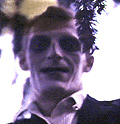 This is a color still
of Hinzman in makeup in NOTLD.
This is a color still
of Hinzman in makeup in NOTLD.
Why does Bill Hinzman have his name misspelled Heinzman in the credits?
To make sure people pronounce it right.
What movies reference NOTLD?
A few scenes play out on a television in a house in Halloween II
(1981) and Stir of Echoes (1999). There's a tribute scene in Waxwork
(1988). In the animated Quackbusters (1988), there's a segment called
Night of the Living Duck. There's a part in Tim Burton's
Beetlejuice (1988) where the movie is
mentioned.
What music acts have referenced NOTLD?
The title itself has been applied to songs by death metallers Entombed and
punk band Misfits. Cds of the same name have been released by the Dead Boys
(1995) and Jackyl (1996). The rap act Public Enemy had a song called Night of
the Living Baseheads (1988). The rock group Seven Year Bitch thought it'd be
fun to use Karen Cooper's face for a logo and drumhead art during the late
80s-early 90s.
What TV shows have referenced NOTLD?
Saturday Night Live’s sketch "Night of the Moonies" was one of
the most well-known references; MTV’s Liquid Television had a segment called
Stick Figure Theater which re-enacted NOTLD in 1994.
What parodies have there been of NOTLD?
The most famous is Night of the Living Bread, a short by Kevin S.
O'Brien. You can see this on the old Anchor Bay VHS double set or the Elite
Laserdisc or DVD. Nickelodeon used to have a program called Mad Movies, where
classic movies were redubbed and they did NOTLD for one episode in 1986. Michael
Medved also shows up to talk about the significance of the movie.
The ultimate parody is no doubt Night of the Day of the Dawn of the Son of
the Bride of the Return of the Revenge of the Terror of the Attack of the Evil
Mutant Hellbound Flesheating Subhumanoid Living Dead Part 2 in Shocking
2D released in 1992 on Jivass Video. All this was is the movie dubbed over
by one man doing all kinds of voices. Parts are quite funny.
What other cultural references have there
been for NOTLD?
Too many to keep track of honestly. In Halloween 1989, Budweiser released a
black and white commercial that paid homage to the beginning. The 1992 Super
Nintendo/Sega Genesis video game Zombies Ate My Neighbors! featured a
familiar image from NOTLD of zombies.
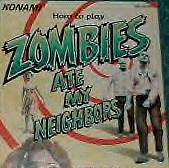
Is Return of the Living Dead supposed to be the sequel?
John Russo wrote a sequel to his NOTLD Novel in 1978. That was his sequel
which was still limited to Pennsylvania countrysides not about the whole
world being taken over by the zombies (something George's movie sequels were
about).
Why did John Russo make the movie Return of the Living Dead?
John Russo made the novel which was in turn purchased by another producer
and turned into a much better movie that was completely different. Russo had
NOTHING to do with the shooting of the film. The original novel is discussed in
detail here. Russo also
took it upon himself to novelize the film - changing events and names left and
right to drag it out to novel proportion. Find out what he changed here.
Why did John Russo make Children of the Living Dead?
He didn't write it, he didn't direct either. He was in on it though. But
don't blame him entirely!
Why did Bill Hinzman make Revenge of the
Living Dead (Flesheater)?
Notice any kind of pattern here?
Why is Russ Streiner not credited as Johnny?
Why isn't George Romero or John Russo for that matter? They didn't want to
be.
What did George think of the 30th Anniversary Edition or of Children of the
Living Dead?
He is on our side. He has been quoted as saying "he is still friends
with Jack Russo" but both on and off the record "doesn't like what
they did".
What do you think of the 1990 remake?
It improved on the realism, the makeup was worth a look, but was it as good
as the original? No way. Check out my site on it.
How much money has NOTLD made worldwide?
It is estimated that it has made $70 million to date but these dollars have
not gone to the people who were initially behind it.
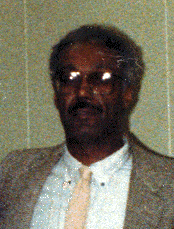 A shot of Duane
Jones from 1985, taken by Stephen D'Emidio.
A shot of Duane
Jones from 1985, taken by Stephen D'Emidio.
What has the cast done besides NOTLD/who has since died?
Duane Jones went on to star in several more low-budget, obscure films: Ganja
and Hess (1972), Tarot (1975), Losing Ground (1982), Beat
Street (1984), Abandon (86), Fright House (1988), Negatives
(1988); he died July 22, 1988 of heart failure and To Die For (1989)
ironically was dedicated to his memory. Jones stated in his last interview that
he had not seen any other Romero (or any other Living Dead) movies. Russel
Streiner went on to produce sex romp The Booby Hatch in 1975 with John
Russo, and the remake of Night of the Living Dead. He married co-star
Judith Ridley who appeared as Judith Streiner in Romero’s farce There’s
Always Vanilla (1971) alongside of George Kosana. Karl Hardman appeared with
Marilyn Eastman in Santa Claws (1996). Eastman (who also was in Houseguest
in 1995) co-starred in Fade To Black (1980) with Kyra Schon. Santa
Claws which was directed by S. William Hinzman, who also directed Flesheater
(aka Revenge of the Living Zombie) released to video in 1988.
Hinzman worked as a cinematographer on Romero’s early films from There’s
Always Vanilla, Jack’s Wife (1972) and The Crazies which
also starred A.C. McDonald. Hinzman also photographed Russo’s The
Majorettes (1986), Backstreet Justice (1992), Stephen King’s The
Langoliers (1995, made for TV) as well as Legion of the Night and Evil
Ambitions (both 1996). His most recent effort was the 1998 Night of the
Living Dead 30th Anniversary travesty and its sequel Children
of the Living Dead (2001). Vince Survinski served as production manager on a
few of Romero’s films, appearing in Martin and Day of the Dead
before his death on May 7, 2001. Bill Cardille reprised his role as a reporter
in the 1990 Night remake and six years later in The Assassination File.
Tony Pantanello and Regis Survinski both appeared in Romero’s Martin
(1977). Keith Wayne worked as a singer and later chiropractor, before committing
suicide on Sept. 9, 1995. Betty Ellen Haughey died in 1971 shortly after Night’s
infamy really caught on. And John Russo is well, in a very bitter world of his
own...waiting his own day to come.
Copyright © 2003 T5